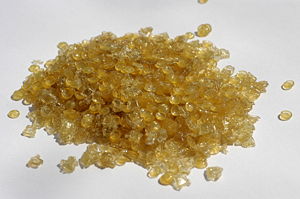
Animal glue is an adhesive that is created by prolonged boiling of animal connective tissue in a process called rendering.[1] In addition to being used as an adhesive, it is used for coating and sizing, in decorative composition ornaments, and as a clarifying agent.[1]
These protein colloid glues are formed through hydrolysis of the collagen from skins, bones, tendons, and other tissues, similar to gelatin. The word collagen itself derives from Greek κόλλα (kolla), meaning 'glue'. These proteins form a molecular bond with the glued object.[citation needed] Conventionally, keratin glues, while made from animal parts like horns and hooves, are not considered animal glues as they are not collagen glues.[2]
Stereotypically, the animal in question is a horse, and horses that are put down are often said to have been "sent to the glue factory". However, other animals are also used, including cattle,[3] rabbits and fish.[4]
- ^ a b Animal Glue In Industry. New York, N.Y.: National Association of Glue Manufactures, Inc. 1951. p. 1. ASIN B000CQXC8Y.
- ^ "adhesive | Definition, Types, Uses, Materials, & Facts | Britannica". www.britannica.com.
- ^ Animal Glue In Industry. New York, N.Y.: National Association of Glue Manufactures, Inc. 1951. p. 3. ASIN B000CQXC8Y.
- ^ Mayer, Ralph (1991). The Artist's Handbook of Materials and Techniques. New York: Viking. p. 437. ISBN 0-670-83701-6.
Isinglass is a superlative grade of fish glue made by washing and drying the inner layers of the sounds (swimming bladders) of fish. The best grade, Russian isinglass, is obtained from the sturgeon.